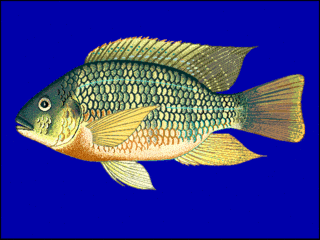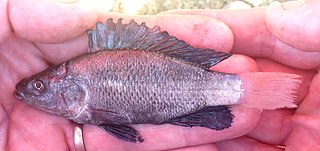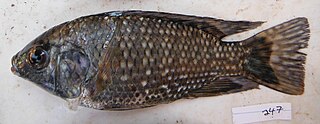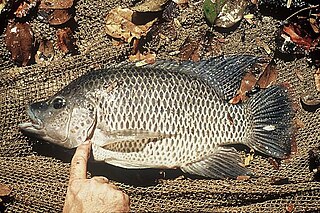
Cichlids are fish from the family Cichlidae in the order Cichliformes. Traditionally Cichlids were classed in a suborder, the Labroidei, along with the wrasses (Labridae), in the order Perciformes, but molecular studies have contradicted this grouping. On the basis of fossil evidence, it first appeared in Tanzania during the Eocene epoch, about 46–45 million years ago. The closest living relative of cichlids is probably the convict blenny, and both families are classified in the 5th edition of Fishes of the World as the two families in the Cichliformes, part of the subseries Ovalentaria. This family is large, diverse, and widely dispersed. At least 1,650 species have been scientifically described, making it one of the largest vertebrate families. New species are discovered annually, and many species remain undescribed. The actual number of species is therefore unknown, with estimates varying between 2,000 and 3,000.

Lake Malawi, also known as Lake Nyasa in Tanzania and Lago Niassa in Mozambique, is an African Great Lake and the southernmost lake in the East African Rift system, located between Malawi, Mozambique and Tanzania.

Tilapia is the common name for nearly a hundred species of cichlid fish from the coelotilapine, coptodonine, heterotilapine, oreochromine, pelmatolapiine, and tilapiine tribes, with the economically most important species placed in the Coptodonini and Oreochromini. Tilapia are mainly freshwater fish inhabiting shallow streams, ponds, rivers, and lakes, and less commonly found living in brackish water. Historically, they have been of major importance in artisanal fishing in Africa, and they are of increasing importance in aquaculture and aquaponics. Tilapia can become a problematic invasive species in new warm-water habitats such as Australia, whether deliberately or accidentally introduced, but generally not in temperate climates due to their inability to survive in cold water.

The Nile tilapia is a species of tilapia, a cichlid fish native to parts of Africa and the Levant, particularly Israel and Lebanon. Numerous introduced populations exist outside its natural range. It is also commercially known as mango fish, nilotica, or boulti.

Oreochromis is a large genus of oreochromine cichlids, fishes endemic to Africa and the Middle East. A few species from this genus have been introduced far outside their native range and are important in aquaculture. Many others have very small ranges; some are seriously threatened, and O. ismailiaensis and O. lidole possibly are extinct. Although Oreochromis primarily are freshwater fish of rivers, lakes and similar habitats, several species can also thrive in brackish waters and some even survive in hypersaline conditions with a salinity that far surpasses that of seawater. In addition to overfishing and habitat loss, some of the more localized species are threatened by the introduction of other, more widespread Oreochromis species into their ranges. This is because they—in addition to competing for the local resources—often are able to hybridize.

Sarotherodon is a genus of oreochromine cichlids that are native to the northern half of Africa, with a single species, S. galilaeus, also ranging into the Levant. A couple of species from this genus have been introduced far outside their native range, and are important in aquaculture. Most other species have small ranges and some are seriously threatened. They mainly inhabit fresh and brackish water, but a few can live in salt water. Species in this genus, as well as those in several other oreochromine and tilapiine genera, share the common name "tilapia" and historically they were included in the genus Tilapia.
Ethelwynn Trewavas was an ichthyologist at the British Museum of Natural History. She was known for her work on the families Cichlidae and Sciaenidae. She worked with Charles Tate Regan, another ichthyologist and taxonomist.

Tilapia is a genus of cichlid fishes endemic to freshwater habitats in Southern Africa. In the past this was a very large genus including all species with the common name tilapia, but today the vast majority are placed in other genera.

The Tilapiini are a tribe within the family Cichlidae commonly known as tilapiine cichlids. Formerly this tribe contained many other genera and species, including the economically important Oreochromis and Sarotherodon, but a taxonomic review found that this grouping was paraphyletic and most were moved to Coelotilapini, Coptodonini, Heterotilapini, Oreochromini and Pelmatolapiini. Together, most species in these tribes are called "tilapias". In a more distant past, a number of other, more different genera like Steatocranus also were included in Tilapiini. With these as separate, Tilapiini now is a much more restricted tribe with only three genera and about half a dozen species from Central and Southern Africa.

Tilapia has become the third most important fish in aquaculture after carp and salmon; worldwide production exceeded 1.5 million metric tons in 2002 and increases annually. Because of their high protein content, large size, rapid growth, and palatability, a number of coptodonine and oreochromine cichlids—specifically, various species of Coptodon, Oreochromis, and Sarotherodon—are the focus of major aquaculture efforts.

Corematodus shiranus is a species of haplochromine cichlid fish native to Lake Malawi, Lake Malombe and the upper reaches of the Shire River in East Africa. It is an aggressive mimic of the chambo cichlids in both color pattern and swimming mode. It is therefore able to approach unsuspecting schools of these species and rapidly take a mouthful of scales or fin. Due to overfishing, the chambo cichlid populations have drastically declined, adversely affecting C. shiranus, which was last reported in 1997 and might now be extinct.

Oreochromis amphimelas is a species of tilapia cichlid endemic to north–central Tanzania, where it is found in Lake Manyara and a number of other saline lakes with closed basins. Maximum recorded size is 28 cm (11 in) in standard length.

Oreochromis karongae is a critically endangered species of cichlid that is endemic to Lake Malawi, Lake Malombe, and upper and middle Shire River in Malawi, Mozambique, and Tanzania. This species is important to local commercial fisheries, but has declined drastically due to overfishing.

Oreochromis leucostictus is a species of cichlid native to Albertine Rift Valley lakes and associated rivers in DR Congo and Uganda. It has now been introduced widely elsewhere East Africa, and is believed to have negative ecological impact, particularly on native tilapias. This species is reported to reach a standard length of up to 36.3 cm (14.3 in), but is usually much smaller. It is exploited by small-scale fishery and aquaculture operations.

Oreochromis squamipinnis is a critically endangered species of cichlid fish that is endemic to Lake Malawi, Lake Malombe and Shire River in East Africa, where found in a wide range of habitats, but especially in shallow water. This species is important to local commercial fisheries and can also be found in the aquarium trade, but it has declined drastically due to overfishing.

Oreochromis variabilis, the Victoria tilapia, is a species of African cichlid native to Lake Victoria and its tributaries, Lake Kyoga, Lake Kwania, and Lake Bisina (Salisbury), as well as being found in the Victoria Nile above Murchison Falls. This species can reach a standard length of 30 cm (12 in). This species is important to local commercial fisheries and is potentially important in aquaculture. It is also found in the aquarium trade.

The mango tilapia is a species of fish from the cichlid family that is native to fresh and brackish waters in Africa and the Levant. Other common names include Galilaea tilapia, Galilean comb, Galilee St. Peter's fish, and St. Peter's fish. This is a relatively large cichlid at up to 41 centimetres (16 in) in total length and about 1.6 kilograms (3.5 lb) in weight. It is very important to local fisheries and the species is also aquacultured.
Oreochromis saka is a species of cichlid fish that is endemic to Lake Malawi and Lake Malombe in East Africa where it inhabits relatively shallow coastal areas. It can reach a standard length of 36 cm (14 in). It is part of the subgenus Nyasalapia, which are known as chambo. The validity of this species is questionable and a taxonomic review recommended that it should be considered a synonym of O. karongae.

Oreochromini is a tribe of cichlids in the Pseudocrenilabrinae subfamily that is native to Africa and Western Asia, but a few species have been widely introduced to other parts of the world. It was formerly considered to be part of the tribe Tilapiini but more recent workers have found that the Tilapiini sensu lato is paraphyletic. Despite this change, species in Oreochromini are still referred to by the common name tilapia and some of the most important tilapia in aquaculture —certain species of Oreochromis and Sarotherodon— are part of this tribe. In contrast, several species have small ranges and are seriously threatened; a few are already extinct or possibly extinct.

Oreochromis mortimeri, the Kariba tilapia or kurper bream, is a species of cichlid, formerly classified as a Tilapiine cichlid but now placed in the genus Oreochromis, the type genus of the tribe Oreochromini of the subfamily Pseudocrenilabrinae. It is found in the rivers of south central Africa especially the middle Zambezi where it is endangered by the spread of invasive congener Oreochromis niloticus.



















